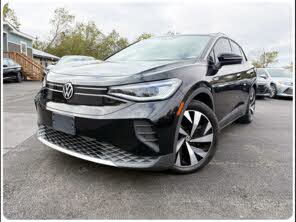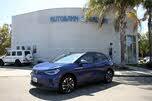2021 Volkswagen ID.4 vs 2021 Honda CR-V
Overview | |
MSRP$39,995 | MSRP$25,350 |
Listings396 | Listings1266 |
Ratings & Reviews | |
User Reviews | User Reviews |
Expert reviews7.3 out of 10 | Expert reviews7.8 out of 10 |
Pros
Cons
| Pros
Cons
|
2021 Volkswagen ID.4 Reviews SummaryThe “Dieselgate” emissions scandal forced Volkswagen to double down on electric cars, and now we’re finally seeing the first result of that: the 2021 Volkswagen ID.4 electric crossover. VW has made an electric car before, but its last attempt, the e-Golf, was built to satisfy emissions standards, not rack up sales. It was barely advertised, and it was sold only in certain states. That’s not the case with the ID.4, which will be available nationwide and will even be built in Tennessee starting in 2022. Volkswagen views the ID.4 as a rival not to other EVs, but to mainstream gasoline vehicles like the Honda CR-V and Toyota RAV4. Being late to the party means there are already several other EVs trying to coax new-car buyers away from internal combustion, however. If you want a reasonably-priced EV, the Nissan Leaf, Hyundai Kona Electric, and Kia Niro EV already exist, and General Motors just announced the 2022 Chevrolet Bolt EUV—a new variant of the Chevy Bolt EV with a crossover body style similar to the Volkswagen. We tested an ID.4 1st Edition, which commemorates the car’s launch, and an ID.4 PRO S with all-wheel drive (AWD). The 1st Edition is a limited-edition model that has already sold out, but it’s mechanically identical to the ID.4 Pro S AWD, albeit with power sent only to the rear wheels. | |
2021 Honda CR-V Reviews SummaryEven in a grim year, Honda is selling a staggering number of CR-Vs. The CR-V is the best-selling Honda by far. It’s also the second best-selling compact SUV, just behind the Toyota RAV4. And it's the fifth best-selling vehicle in the U.S., and if you take out all the commercial sales of full-size pickups it’s one of the two best-selling vehicles year in and year out. So it’s hard to argue against the CR-V formula. Honda’s been at this almost as long as crossovers have been a thing, launching the CR-V in 1997—a year after the RAV4 debuted. The funny thing is, aside from sales volume, there’s only one thing the CR-V particularly excels at. Aesthetics are subjective, but it would be hard to argue the CR-V is the best looking vehicle in its class. It’s not the cheapest. It’s not the best equipped, especially at the middle to lower trim levels. It’s not the fastest, nor is it the quietest, or the most fuel efficient. It’s not even the most reliable, showing up nowhere in J.D. Power's Most Reliable list. So what makes it so appealing to American consumers? Let’s see if we can figure that out. | |
No video found | |
Popular Features & Specs | |
Engine201 hp Electric | Engine1.5L 190 hp I4 |
Drive TrainRWD | Drive TrainFWD |
Seating Capacity5 | Seating Capacity5 |
Horsepower | Horsepower190 hp @ 5600 rpm |
EV Battery Capacity82 kWh | EV Battery Capacity |
MPG City104 | MPG City28 |
MPG Highway89 | MPG Highway34 |
Battery Charge Time (240V)8 hours | Battery Charge Time (240V) |
Engine | |
Engine Name201 hp Electric | Engine Name1.5L 190 hp I4 |
Torque | Torque179 lb-ft @ 2000 rpm |
Horsepower | Horsepower190 hp @ 5600 rpm |
Battery Charge Time (240V)8 hours | Battery Charge Time (240V) |
DrivetrainRWD | DrivetrainFWD |
Fuel Economy | |
EV Battery Capacity82 kWh | EV Battery Capacity |
MPG City104 | MPG City28 |
MPG Highway89 | MPG Highway34 |
Interior | |
Seating Capacity5 | Seating Capacity5 |
Safety | |
Front Crash Overall5 | Front Crash Overall5 |
Side Crash Overall5 | Side Crash Overall5 |
Dimensions & Capacity | |
Cargo Space30.3 cu ft | Cargo Space39.2 cu ft |
Curb Weight4517 lbs | Curb Weight3337 lbs |
Height64.4 in | Height66.1 in |
Length180.5 in | Length182.1 in |
Width72.9 in | Width73.0 in |
Wheelbase108.9 in | Wheelbase104.8 in |
Maximum Payload1347 lbs | Maximum Payload1358 lbs |
Number of doors4 | Number of doors4 |
Maximum Towing Capacity | Maximum Towing Capacity1500 lbs |
Overview | ||
MSRP | $39,995 | $25,350 |
Listings | ||
Ratings & Reviews | ||
User reviews | ||
Expert reviews | 7.3 out of 10Read full review | 7.8 out of 10Read full review |
Pros & cons | Pros
Cons
| Pros
Cons
|
Summary | The “Dieselgate” emissions scandal forced Volkswagen to double down on electric cars, and now we’re finally seeing the first result of that: the 2021 Volkswagen ID.4 electric crossover. VW has made an electric car before, but its last attempt, the e-Golf, was built to satisfy emissions standards, not rack up sales. It was barely advertised, and it was sold only in certain states. That’s not the case with the ID.4, which will be available nationwide and will even be built in Tennessee starting in 2022. Volkswagen views the ID.4 as a rival not to other EVs, but to mainstream gasoline vehicles like the Honda CR-V and Toyota RAV4. Being late to the party means there are already several other EVs trying to coax new-car buyers away from internal combustion, however. If you want a reasonably-priced EV, the Nissan Leaf, Hyundai Kona Electric, and Kia Niro EV already exist, and General Motors just announced the 2022 Chevrolet Bolt EUV—a new variant of the Chevy Bolt EV with a crossover body style similar to the Volkswagen. We tested an ID.4 1st Edition, which commemorates the car’s launch, and an ID.4 PRO S with all-wheel drive (AWD). The 1st Edition is a limited-edition model that has already sold out, but it’s mechanically identical to the ID.4 Pro S AWD, albeit with power sent only to the rear wheels. | Even in a grim year, Honda is selling a staggering number of CR-Vs. The CR-V is the best-selling Honda by far. It’s also the second best-selling compact SUV, just behind the Toyota RAV4. And it's the fifth best-selling vehicle in the U.S., and if you take out all the commercial sales of full-size pickups it’s one of the two best-selling vehicles year in and year out. So it’s hard to argue against the CR-V formula. Honda’s been at this almost as long as crossovers have been a thing, launching the CR-V in 1997—a year after the RAV4 debuted. The funny thing is, aside from sales volume, there’s only one thing the CR-V particularly excels at. Aesthetics are subjective, but it would be hard to argue the CR-V is the best looking vehicle in its class. It’s not the cheapest. It’s not the best equipped, especially at the middle to lower trim levels. It’s not the fastest, nor is it the quietest, or the most fuel efficient. It’s not even the most reliable, showing up nowhere in J.D. Power's Most Reliable list. So what makes it so appealing to American consumers? Let’s see if we can figure that out. |
Video | No video found | |
Popular Features & Specs | ||
Engine | 201 hp Electric | 1.5L 190 hp I4 |
Drive Train | RWD | FWD |
Seating Capacity | 5 | 5 |
Horsepower | 190 hp @ 5600 rpm | |
EV Battery Capacity | 82 kWh | |
MPG City | 104 | 28 |
MPG Highway | 89 | 34 |
Battery Charge Time (240V) | 8 hours | |
Engine | ||
Engine Name | 201 hp Electric | 1.5L 190 hp I4 |
Torque | 179 lb-ft @ 2000 rpm | |
Horsepower | 190 hp @ 5600 rpm | |
Battery Charge Time (240V) | 8 hours | |
Drivetrain | RWD | FWD |
Fuel Economy | ||
EV Battery Capacity | 82 kWh | |
MPG City | 104 | 28 |
MPG Highway | 89 | 34 |
Interior | ||
Seating Capacity | 5 | 5 |
Safety | ||
Front Crash Overall | 5 | 5 |
Side Crash Overall | 5 | 5 |
Dimensions & Capacity | ||
Cargo Space | 30.3 cu ft | 39.2 cu ft |
Curb Weight | 4517 lbs | 3337 lbs |
Height | 64.4 in | 66.1 in |
Length | 180.5 in | 182.1 in |
Width | 72.9 in | 73.0 in |
Wheelbase | 108.9 in | 104.8 in |
Maximum Payload | 1347 lbs | 1358 lbs |
Number of doors | 4 | 4 |
Maximum Towing Capacity | 1500 lbs | |
The 2021 Volkswagen ID.4 was designed as an electric vehicle from the ground up, showcasing a distinctive look that set it apart from Volkswagen's gasoline models. It featured a streamlined profile with wheels pushed out to the corners, eschewing the straight lines and sharp angles of the Tiguan and Atlas crossovers. The ID.4's interior combined Volkswagen's minimalist design with a tech-focused aesthetic, featuring piano black and matte plastic finishes. Standard features included a leather-wrapped steering wheel and cloth seats, with leatherette upholstery available on higher trims.
In contrast, the 2021 Honda CR-V had a more conventional design that blended in with other compact crossovers. While it had a few distinguishing features like the grille and some chromed plastic elements, its overall look was similar to its competitors. The CR-V was available in eight colors, though many were shades of gray, black, or white, with more vibrant options limited to higher trims. Inside, the CR-V offered black, gray, and ivory cloth or leather upholstery, with wood panels and chrome accents available on higher trims. The seats had a modern, angular design, but the overall styling was less distinctive compared to some competitors.

















The 2021 Volkswagen ID.4 launched with a single rear-mounted electric motor producing 201 horsepower and 229 pound-feet of torque, powered by an 82-kilowatt-hour battery pack. This rear-wheel-drive (RWD) setup was a first for Volkswagen in the U.S. since the Beetle. An all-wheel-drive (AWD) version with a second motor arrived later in 2021, boosting power to 295 horsepower and 339 pound-feet of torque. The ID.4 offered balanced handling and smooth acceleration, though it was tuned more for comfort than sportiness. Regenerative braking was minimal, with VW opting for a more traditional driving experience.
The 2021 Honda CR-V, regardless of trim, came with a 190-horsepower turbocharged four-cylinder engine paired with a continuously variable transmission (CVT). It accelerated from 0 to 60 mph in about 7.8 seconds, which was competitive within its segment. The CR-V offered a smooth and predictable driving experience, though it lacked the engagement of some competitors with more conventional transmissions. Front-wheel drive (FWD) was standard, with AWD available as an option. The CR-V's suspension setup provided decent handling and ride quality, similar to other vehicles in its class.
The 2021 Volkswagen ID.4 offered more front and rear headroom compared to other EVs, though its legroom was average for the segment. It provided 30.3 cubic feet of cargo space with the rear seats up and 64.2 cubic feet with them folded, which was more than some EV competitors but less than the Honda CR-V and Toyota RAV4. The ID.4 lacked a front trunk (frunk), but its interior felt spacious, with good forward visibility. However, rearward visibility was hindered by thick rear pillars and a small back window. The center console had limited storage space, though it included several places to store a phone.
The 2021 Honda CR-V excelled in interior space, offering 102.9 cubic feet of passenger volume and 75.8 cubic feet of total cargo volume with the rear seats folded. The CR-V's cargo area could be accessed via a manual tailgate on lower trims, a power tailgate on the EX-L, and a hands-free power tailgate on the Touring trim. Roof rails were standard only on the top Touring trim. The CR-V's interior was designed to comfortably fit five people and their gear, making it a practical choice for families.
The 2021 Volkswagen ID.4 came standard with a 10-inch touchscreen infotainment system (with an optional 12-inch screen) featuring wireless Apple CarPlay and Android Auto. A 5.3-inch display served as the instrument cluster, and haptic touchpads replaced most physical controls. While the setup looked modern, it was difficult to use due to the lack of tactile feedback. The ID.4 also included a natural-language voice-control system and the ID.Light feature, which communicated information through a light strip at the base of the windshield. Despite some gimmicky features, the touchscreen was well-positioned and easy to navigate.
The 2021 Honda CR-V's base LX trim had a 5-inch color screen with Bluetooth connectivity, while other trims featured a 7-inch high-definition touchscreen with Apple CarPlay and Android Auto. The audio system varied by trim, with the Touring trim offering a 300-watt system with a subwoofer. Charging ports were plentiful, with USB ports in the front and second rows, and a wireless phone charger available on the Touring trim. The Touring trim also included a satellite navigation system with voice recognition.
The 2021 Volkswagen ID.4 received the highest-level Top Safety Pick+ designation from the Insurance Institute for Highway Safety (IIHS) and a five-star rating from the National Highway Traffic Safety Administration (NHTSA) for the RWD model. Standard safety features included forward-collision warning, automatic emergency braking, blind-spot monitoring, lane-keep assist, park distance control, automatic high beams, and adaptive cruise control. The ID.4 also introduced Travel Assist and Emergency Assist, enhancing its safety suite.
The 2021 Honda CR-V earned a five-star overall crash test rating from the NHTSA and a Top Safety Pick award from the IIHS, though it missed the Top Safety Pick+ rating due to lower scores in headlight evaluation and the updated side crash test. The CR-V's standard Honda Sensing system included a multi-angle rearview camera, forward collision warning, lane departure warning, automatic emergency braking, road departure mitigation, lane keeping assist, adaptive cruise control, and auto high-beam headlamps. Blind spot monitoring with rear cross-traffic alert was standard from the EX trim upwards.
CarGurus highlights

According to CarGurus experts, the overall rating for the 2021 Volkswagen ID.4 is 7.3 out of 10, while the 2021 Honda CR-V scores 7.8 out of 10. Based on these ratings, the 2021 Honda CR-V is the better choice, offering more interior space, a comprehensive suite of standard safety features, and a practical, family-friendly design.
Choose the 2021 Volkswagen ID.4 if:
- You prefer an all-electric vehicle with a modern, tech-focused interior.
- You value a smooth and comfortable ride with balanced handling.
- You want advanced safety features and driver aids as standard.
Choose the 2021 Honda CR-V if:
- You need a spacious interior with ample cargo capacity for family trips.
- You prioritize safety and want a comprehensive suite of standard safety features.
- You prefer a conventional gasoline engine with predictable performance.
CarGurus highlights

According to CarGurus experts, the overall rating for the 2021 Volkswagen ID.4 is 7.3 out of 10, while the 2021 Honda CR-V scores 7.8 out of 10. Based on these ratings, the 2021 Honda CR-V is the better choice, offering more interior space, a comprehensive suite of standard safety features, and a practical, family-friendly design.
Choose the 2021 Volkswagen ID.4 if:
Shop Now- You prefer an all-electric vehicle with a modern, tech-focused interior.
- You value a smooth and comfortable ride with balanced handling.
- You want advanced safety features and driver aids as standard.
Choose the 2021 Honda CR-V if:
Shop Now- You need a spacious interior with ample cargo capacity for family trips.
- You prioritize safety and want a comprehensive suite of standard safety features.
- You prefer a conventional gasoline engine with predictable performance.

By: CarGurus + AI
At CarGurus, our team of experienced automotive writers remain at the heart of our content operation, conducting hands-on car tests and writing insightful guides that are backed by years of industry experience. To complement this, we are harnessing AI to make our content offering more diverse and more helpful to shoppers than ever. To achieve this, our AI systems are based exclusively on CarGurus content, ratings and data, so that what we produce is both unique to CarGurus, and uniquely helpful to car shoppers.







































